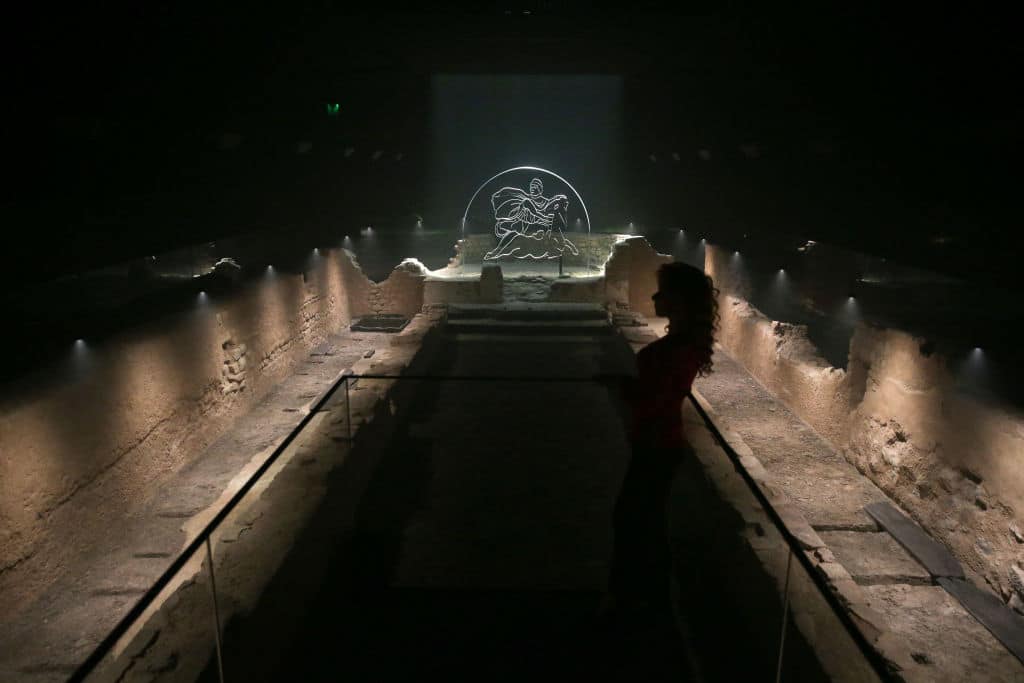I took myself off on a jaunt through London last month, following a favourite route through two cities (the other being Westminster) which takes in plenty of interesting old things for those with eyes to see. I started at the Mithraeum, a pagan temple dedicated to the cult of Mithras, deep under the Bloomberg building next to Cannon Street Station.
I always think that when the phrase “Britain is a Christian country” gets bandied round – very often by non-churchgoers, it seems – it makes it sound as though Christianity was some kind of default option for the nation, starting with a series of unlikely, if pious, legends. “And was the Holy Lamb of God on England’s pleasant pastures seen?”
The spiritual aspirations of William Blake’s Jerusalem are worthy, noble and brave: “Bring me my bow of burning gold; bring me my arrows of desire.” They were surely the attributes of Aidan, Columba, Augustine and their companions. But the victory belonged to prayer, work, courage and self-sacrifice for centuries after Alban suffered.
“I have no pleasure in the blood of bulls,” God tells Isaiah in the opening verses of his visions; so that rules out the Mithraeans. The ruins of their meeting house, where they took part in the rituals of a cult in which bullock-sacrifice featured prominently – well-preserved, superbly presented and well worth a visit – speak evocatively of their transience.
We might have been none the wiser about the Mithraeum had it not been for the Blitz, for it emerged from the rubble when the streets were being rebuilt later. Perhaps a better description would be “rebuilt again”. Buried deep under layers of history, the Great Fire of 1666 simply swept overhead. At ground level it was a different story.
I have often thought that if I had the chance to be transported temporarily anywhere in the past, then I might like to visit London on the eve of the catastrophe, to see all those medieval churches, about a hundred in a square mile, crammed together in the narrow streets with their spires reaching for the clouds.
Eighty-six of them were destroyed – including the soaring old St Paul’s Cathedral, one of the finest buildings in the world – and 52 rebuilt. All were designed for Anglican worship, of course, and the authorities later took care to ensure that the blame for the conflagration fell – ludicrously – on the local Catholic population.
An inscription was later added to Robert Hooke’s Monument, on the site of St Margaret’s, New Fish Street, the first church to be burn-ed down. <em>Furor papisticus qui tamdiu patravit nondum restinguitur</em>, it ran: “Popish frenzy, which was responsible for many horrible things for so long, is yet to be extinguished.”
Alexander Pope, a Catholic himself (nominative determinism strikes again) later named the falsehood in his Moral Essays in 1734: “London’s column, pointing at the skies / Like a tall bully, lifts the head and lies.” The offending phrase and others like it were chiselled out in 1830, a year after Catholic Emancipation.
Those that survived the city’s second trial by fire, at the hands of the enemies of the King, have evocative names like St Andrew-by-the-Wardrobe, St Lawrence Jewry and St James Garlickhythe. Nestled among them is St Mary Moorfields, the only Catholic church in the City of London, where the traditional-rite <em>Triduum</em> ceremonies used to take place.
Although the spire of St Bride’s, Fleet Street, is the most famous – it is said to be the model for the now-standard multi-tiered wedding cakes – my pet is that of St Peter Cornhill. It is topped with a weathervane in the shape of a giant key, set bolt upright on its bow with its ward as a sail. It turns with the breeze, locking and unlocking the heavens as it goes.
New St Paul’s Cathedral, Christopher Wren’s masterpiece, is surrounded by streets that sing of different days: Ave Maria Lane, Paternoster Row, Amen Court. Down Ludgate Hill and along the Strand, I made a brief detour for refreshment at the Ship Tavern on the north-west corner of Lincoln’s Inn Fields.
Built in 1549, the Ship was also formerly a Mass house that sheltered priests and worshippers alike. History is fickle, for it later suffered the indignity of becoming, for a while, a Masonic lodge. After a glass of something invigorating I pushed on, for it was nearing Passiontide and <em>Quarant’ore </em>was underway at the Brompton Oratory.
I got there expecting to spend some time in quiet, silent reflection, but making my double genuflection once inside, I realised that the organ had just given the playover for <em>Tantum Ergo</em>. Benediction of the Blessed Sacrament was about to begin, and, far away, a priest in a white cope had fallen to his knees. It was serendipitous, or perhaps providential, timing.
From Mithraeum to Oratory; from Rome to Romanitas; from blind paganism to revealed truth, and all in the space of a day. As the monstrance was returned to its throne amid a sea of flickering candles, we sang the antiphon: <em>Adoremus in aeternum sanctissimum sacramentum.</em> In Eastertide, of course, it is replaced, gloriously, with “Alleluia”. <br><br><em>Photo: A reconstruction of the Roman Temple of Mithras, recreated on the site of its original discovery, at the new Bloomberg headquarters in central London, 7 November 2017. The third century reconstructed temple, sits seven metres below the City of London. (Photo by Daniel LEAL / AFP) (Photo by DANIEL LEAL/AFP via Getty Images.)</em>
<strong><strong>This article originally appeared in the April 2024 issue of the <em>Catholic Herald</em>. To subscribe to our award-winning, thought-provoking magazine and have independent and high-calibre counter-cultural Catholic journalism delivered to your door anywhere in the world click</strong> <a href="https://catholicherald.co.uk/easter-24/?swcfpc=1"><mark style="background-color:rgba(0, 0, 0, 0)" class="has-inline-color has-vivid-cyan-blue-color">here</mark></a>.</strong>



